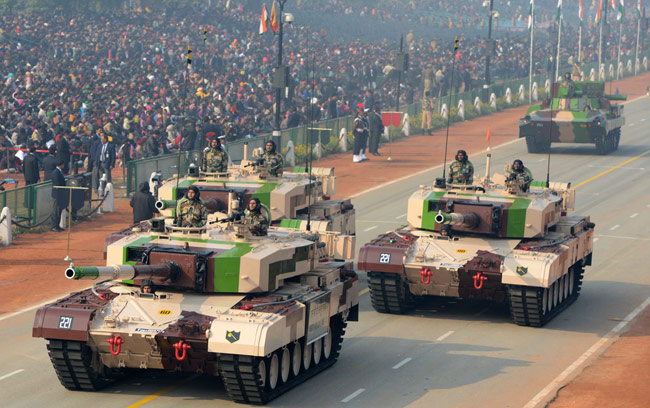Foreign ownership in Indian military
March 24, 2018 | Expert Insights

In a renewed push to attract foreign investment, India plans to allow foreign companies to own bigger stakes in defense joint ventures. With this, the country aims to turn into a global production hub for military hardware.
Background
Over the past three years, India has been named as one of the world’s top arms importers. Industry experts believe that India aims to replace an aging Soviet-era military with up-to-date weapons as a deterrent to China. In 2014-15, India increased its defense spending by 12% and opened the domestic weapons industry to foreign investment to help rebuild the military and constrict the gap with China.
Finance Minister Arun Jaitley stated that “modernization of the armed forces is critical to enable them to play their role effectively in the defense of India’s strategic interests.” In 2014, Jaitley also enhanced the foreign investment limit in the domestic defense industry to 49% from 26%. “Companies controlled by foreign governments and foreign private sector are supplying our defense requirements to us at considerable outflow of foreign exchange,” he noted.
The move to raise investment limits for foreign firms in the defense sector has seen continuous support over the last few years. In 2015, the government finalized an estimated US$15 billion contract with Dassault Aviation for the sale of 126 Rafale fighter jets. US government officials have also been pushing hard for US$2.8 billion in delayed sales of Boeing’s Apache attack and Chinook military transport helicopters.
Previously, the Department of Industrial Policy and Promotion of India had introduced a proposal allowing up to 100% foreign direct investment in defense production. Presently, India’s defense sector has gathered close to US$5 million in foreign investment. Foreign firms stated that they need higher investment caps and greater management control in order to develop a bigger industrial base in India.
Analysis
In addition to inviting increased foreign investment, India also plans to promote greater private sector participation in its defense industry, as it believes that the domination by state-run companies is leading to long delays in product development.
The draft Defense Production Policy, introduced in 2018 by the defense ministry, expects a threefold jump in defense industry revenue amounting to 1.7 trillion rupees (US$26 billion) by 2025. By then, it expects India’s defense industry to rank among the global top five. The draft policy says that the government seeks selling lesser stakes in state-run defense enterprises, including Hindustan Aeronautics and Bharat Dynamics, and engages more actively with the private industry to explore the opportunities in the defense sector.
"Foreign Direct Investment up to 74% under automatic route will be allowed in niche technology areas," stated the draft policy. The defense ministry will seek comments until the end of March. In order to come into force, the policy must be approved by the federal cabinet.
According to the Stockholm International Peace Research Institute, India has been the world's largest arms importer from 2013 to 2017, comprising 12% of globally traded arms. "The tensions between India, on the one side, and Pakistan and China, on the other, are fuelling India's growing demand for major weapons, which it remains unable to produce itself," said Siemon Wezeman, senior researcher at the institute.
India has purchased billions of dollars worth of military hardware including fighter jets, warships, aircraft and missiles from its biggest supplier, Russia, as well from the United States, France, and Israel. The country has been trying to upgrade its military to reduce the gap between its aggressive neighbors, China and Pakistan.
To curb its reliance on imported weapons, the draft policy is looking to make India a production base for various defense products such as fighter jets, medium lift and light utility helicopters, warships, missile systems, land combat vehicles, surveillance systems, and electronic warfare systems. This is aimed at making it easier for defense companies to do business within the country and with new defense suppliers. It also aims to liberalize the process of licensing for the industry and rationalize the existing tax structure.
In order to enhance performance of state-run defense companies, the policy plans to combine new technology and machines and eventually upgrading them into making more advanced weapons. The government is also exploring opportunities in acquiring new technologies through mergers and acquisitions globally.
Assessment
Our assessment is that India’s military is coming up with innovative ways to counter potential threats from both China and Pakistan, thus speeding up the pace of arms purchases. We believe that the rise in India’s military spending comes as Western governments are willing to make huge investments by signing multi-billion dollar deals. France and Britain have held talks in India, while the United States, which has built close military ties, is also pushing for faster decisions on arms contracts. We think that India’s goals could be achieved only if the government has a long-term strategy toward developing a local defense industry with active participation of private companies and replacing its obsolete procurement policies.








Comments